Family : Rosaceae
Classification : Wild Rose

Text © Prof. Franca Bessi

English translation by Mario Beltramini
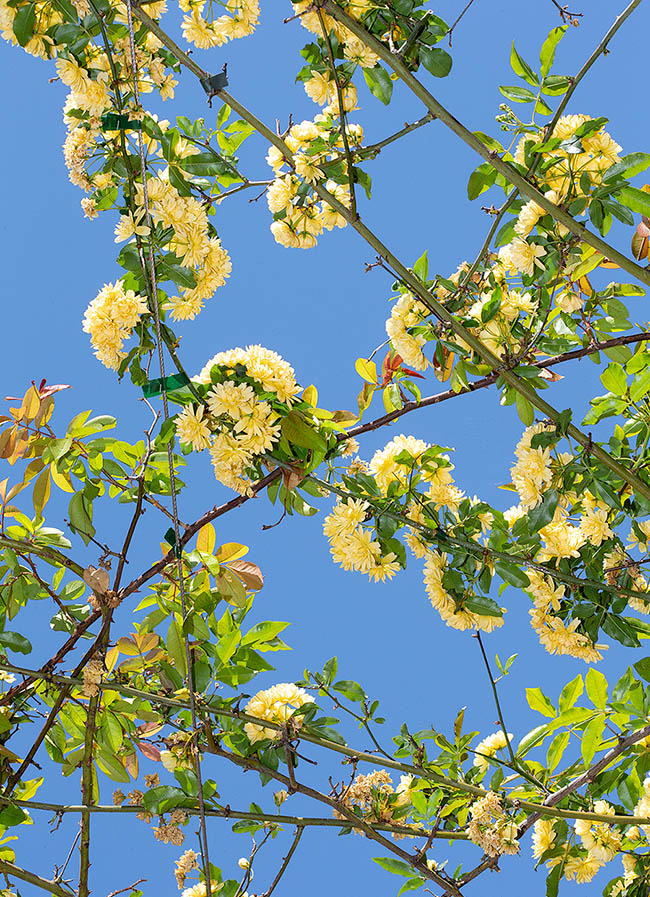
Rosa banksiae ver. lutea is a very vigorous evergreen sarmentose creeper © Giuseppe Mazza
Rosa banksiae W.T.Aiton belongs to the family Rosaceae Juss., tribe Roseae Lam. & DC., genus Rosa L., section Banksianae Lindl.
Rosa banksiae is found validly described the first time in Hortus Kewensis; or, a Catalogue of the Plants Cultivated in the Royal Botanic Garden at Kew. London (ed. 2.) 3: 258. 1811. Despite the fact that the author of the text is William Townsend Aiton (1766-1849), it was believed by some that the enunciation was written by Robert Brown. Based on these different opinions, the binomial denomination Rosa banksiae was attributed either to William T. Aiton as “Hort. Kew., ed. 2 [W.T.Aiton] 3: 258 (1811)” or to Robert Brown as “in W.T.Aiton, Hortus Kew. 3: 258 (1811)”. However, the diagnosis does not contain any references to Robert Brown and not even to his manuscripts “Brown mss.” and therefore, as indicated by the Art. 46 Ex. 25 in International Code of Nomenclature for algae, fungi, and plants (Shenzhen Code) adopted by the Nineteenth International Botanical Congress Shenzhen, China, July 2017, William T. Aiton should be considered as its author.
For instance, this indication is followed by IPNI (International Plant Names Index), by Flora of China (eFloras), by GRIN-Global (U.S. National Plant Germplasm System), by INPN (INPN – Inventaire national du patrimoine naturel), by Tropicos (botanical Database managed by the Missouri Botanical Garden) and by the Portale della Flora d’Italia – Portal to the flora of Italy), whilst POWO (Royal Botanical Garden/Plants of the World Online) and NCBI (National Center for Biotechnology Information) are inclined for Rosa banksiae R.Br. when others, among which eFlore (L’encyclopédie botanique collaborative) and GBIF (Global Biodiversity Information Facility), prefer Rosa banksiae R.Br. ex W.T.Aiton.
Originally the scientific epithet was “Banksiæ” with capital B and rightly the first valid description dated 1811 realizes the link existing between the rose, the denomination and the introduction in England: «Banksiæ. 4. R. inermis lævis glabra, fructibus globosis, foliis ternatis pinnatisque nitidis, stipulis setaceis distinctis. Lady Banks’s Rose. Nat. of China. Mr. William Kerr. Introd. 1807. Fl. June and July. G.H. ♄.»
After this diagnosis, was William Kerr, the plant collector sent by Sir Joseph Banks from London to China, to discover in the nursery of Faa Tee (close to the enclave of the foreign delegations in Canton) Rosa banksiae with double white flowers. In Kew, not by chance, the dedicatee of this rose became Lady Dorothea consort of the mighty Sir Joseph Banks, king’s friend, president for 42 years of the Royal Society, director in pectore of the Kew Gardens and one of the founders of the Horticultural Society of London (1804). The Horticultural Society of London is presently, since 1864, the Royal Horticultural Society (RHS) with five own gardens open to the public (Wisley, Rosemoor, Hyde Hall, Harlow Carr and Bridgewater); the RHS organizes events and exhibitions, among which the most known is the Chelsea Flower Show.
In 1824, upon returning from one of his trips in China, John Damper Parks introduced in England the Rosa banksiae with its cream yellow coloured double corolla (Lady Banks’s Yellow Rose, Rosa banksiae ‘Lutea’), thus satisfying the Horticultural Society request.
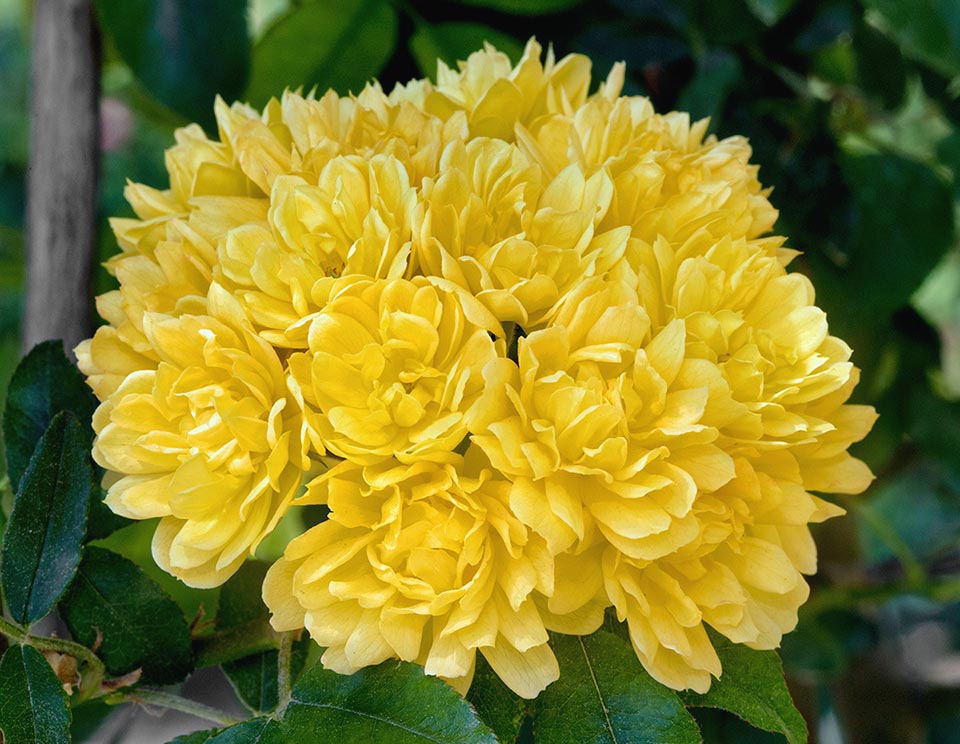
The inflorescences of Rosa banksiae var. lutea bear a considerable number of small and double flowers © Giuseppe Mazza
The distinctive characters of Rosa banksiae are: (inermis lævis glabra) unarmed branches, smooth and glabrous with sarmentose and line-like habit; thorns, when present on the old branches or in not cultivated plants, curved and alternate; (foliis ternatis pinnatisque nitidis) pinnate and ternate leaves, even with 5(-7) segments; leaflets elliptical-ovate or oblong-lanceolate , totally glabrous (but the base of the veins and of the rachis), briefly and simply incised and of a nice green colour; (stipulis setaceis distinctis); filiform, free and deciduous stipule; cluster with small flowers merged in false umbels (umbelliform corymbs) and with very small and deciduous bracts; flowers with white or clear yellow petals, obovate and with cuneate base; free styles, shorter than the stamens, pubescent; ovate entire styles, with sharp apex, abaxially glabrous, adaxially pubescent and deciduous before the maturity of the receptacle; globose rose hips. Depending on the climatic zones it blooms from March to July (Fl. June and July) and fructifies in August-Octobre. It is a sarmentose (♄) shrub that in its area is considered evergreen and that, always depending on the climate, can live outdoors or must be kept in shelter or even in a green-house (G.H. – Green house).
This species is native to central China (Nat. of China). [2n = 14, 28].
In the common lexicon Rosa banksiae has remained related to the first dedicatee or to her husband: Rosier de Banks (normalized common name) and Rosier de Madama Banks (in French); Lady Banks’s Rose and Banksian Rose (in English); Rosa di Banks and Banksia (in Italian); Banks-Rose (in German); Rosal de Banksia and Rosal de Banks (in Spanish).
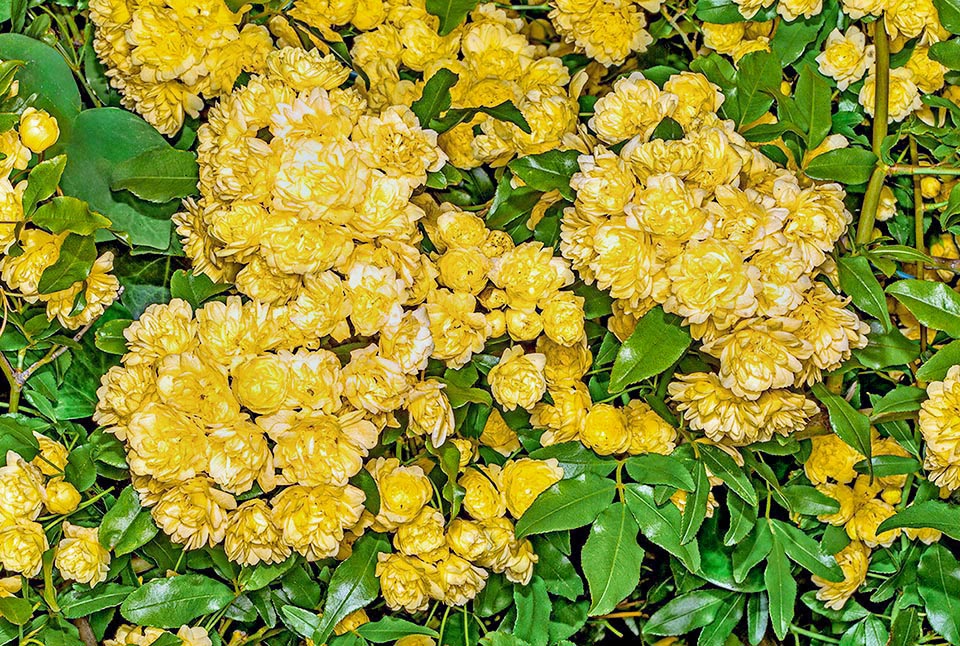
Rosa banksiae var. lutea is considered a very decorative variety due to the great quantity of flowers, though scentless and to the pretty glossy foliage © Giuseppe Mazza
It should be underlined that, despite the name of the species having been initially attributed to a specimen with double white flowers found in a nursery and not in nature, afterwards there was no shortage of news about its origin and diffusion.
In Plantae Wilsonianae (Vol. II) of 1916 is reported that:
1) even if the original has been a cultivated rose, to its typical form belong white flower plants found in nature in Yunnan.
2) Rosa banksiae with white and yellow double flowers is commonly grown in central and southern Japan gardens where it was introduced in 1733 from China.
Around the middle of the nineteenth century were published news about Rosa banksiae with yellow simple flowers
and only in a later time these roses appeared in flower in Europe; some of these flowerings have been historicized in several issues of the “Gardeners Chronicle” mentioning those of Florence and of the Mortola (Imperia).
Following a successful hybridization (1868) done by Paolo Baroni in the Botanical Garden of Florence, where exposed at the International Horticulture Exhibition of 1874 Rosa banksiae with not only yellow but also white simple flowers. In 1878 Sir Thomas Hanbury declared that the “single type of the Banksian Rose” was present in his Mortola Garden since none or ten years; Gertrude Jekyll mentioned the “single yellow Banksian Rose” of Hanbury in Roses for English gardens 1902).
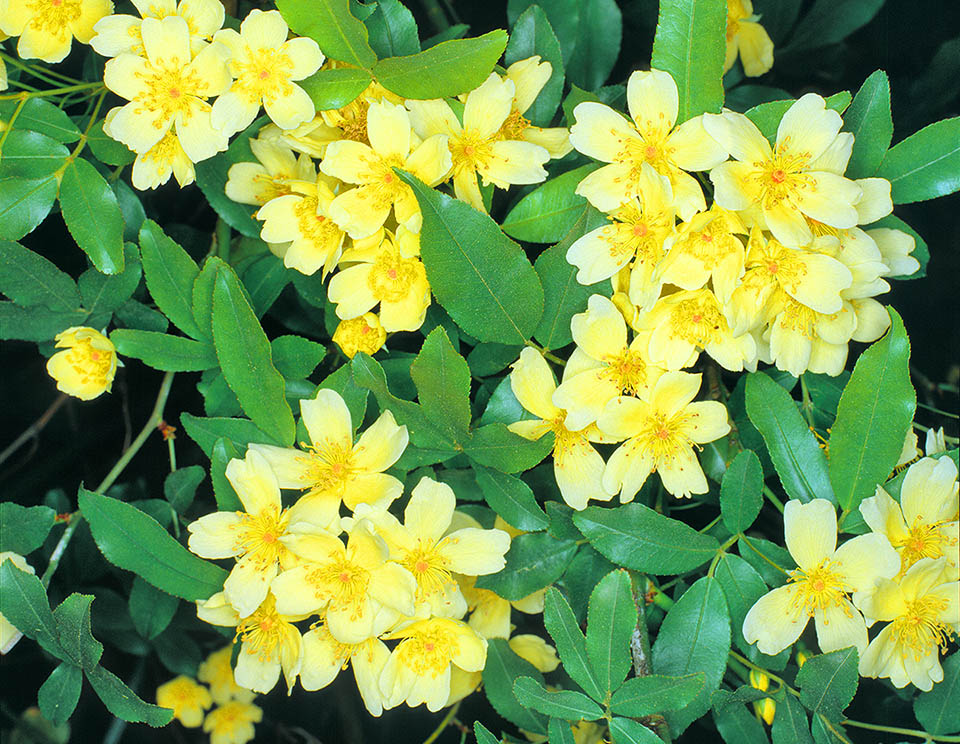
Rosa banksiae f. lutescens has simple flowers, more or less lightly scented © Giuseppe Mazza
Despite the hybridization carried out by Paolo Baroni, also Rosa banksiae with simple flower cannot be considered a cultigen (plant deliberately altered or selected by man) as it has been found in China in the wild state (Hubei in 1907). Moreover, for some authors Rosa banksiae with simple white flowers had already been introduced in Scotland by Robert Drummond and plants at Megginch Castle in 1796, where it remained little known until when some of its cuttings were planted in Nice and flowered there in 1905. The first valid description of Rosa banksiae var. normalis Regel is found in Trudy S.-Peterburgsk. Bot. Sada 5: 375 (1878) with the reference to a plant seen near Beijing.
Rosa banksiae presents in synonymy with two varieties (double or simple flowers) and two forms (white or yellow flowers):
Rosa banksiae var. banksiae W.T.Aiton – white double flowers
Rosa banksiae var. banksiae f. lutea (Lindl.) Rehder – double yellow flowers
Rosa banksiae var. normalis Regel – simple white flowers
Rosa banksiae var. normalis f. lutescens Voss – simple yellow flowers
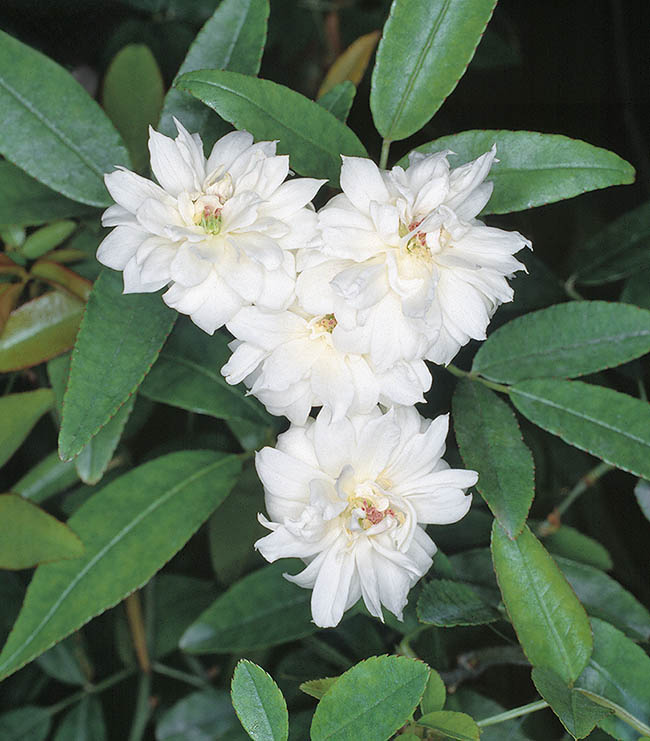
The small double flowers of Rosa banksiae var. banksiae, rich in petals and petaloids, are pleasantly scented © Giuseppe Mazza
Rosa banksiae has been indicated in the Liste de référence des plantes exotiques envahissantes de la région Occitanie (2021) for that region as sub spontaneous exogenous taxon and in Remarks on the exotic flora of Capo Mortola (Ventimiglia, northern Italy) and its changes over time is certified that Rosa banksiae W.T.Aiton var. normalis Regel presents naturalized outside the systems dominated by man for the Ligurian object of study zone.
It is generally used to cultivate Rosa banksiae var. banksiae due to abundant and remarkable blooming and to its qualities of sarmentose plant (climbing). It is a greatly vigorous species capable of changing in the long run the supports on which it is grown and can cover a wall due to the significant dimensions it can reach (generally its development is of 6 m x 12 m). Credited as useful for festooning trees, Rosa banksiae can be grown without being subjected to pruning. Rosa banksiae var. banksiae has more fragrant flowers than Rosa banksiae var. normalis.
The rose bushes of Rosa banksiae with double flowers were immediately highly appreciated and so much utilized that already in 1880 in Florence they were sold with the commercial denominations of “Comune di fior bianco” and “Comune di fior giallo”; however, Rosa banksiae ‘Lutea’ was and still is the mostly employed form in the gardens being a little more rustic and with a more abundant flowering.
Hybrids of Rosa banksiae: Rosa ×fortuneana Lindl. & Paxton, described for the first time in Paxton’s Fl. Gard. 2:71 (1851), and. the artificial hybrid Rosa laevigata Michx. × Rosa banksiae. In the scientific literature Rosa banksiae is reported as the pollen supplier. The common names of this rose are Banks épineux de Chine, Double Cherokee, Fortuniana and Banks de Fortune and its synonym is Rosa fortuneana Lem. It is a sarmentose with the branches equipped with glossy leaves that reaches the 12 m and bears single medium sized flowers with double corolla or more than double and generally of white colour.
The horticultural hybridization of Rosa banksiae var. normalis was brought forward by Dr. Attilio Ragionieri (1856-1933) who obtained Rosa ‘Di Castello’ (1924) and by Quinto Mansuino (1889-1969) of which is still cultivated Rosa ‘Purezza’ (1961). The work of this last hybridizer has originated a group of roses, mostly cut flowers, called by the rhodologists ‘Mansuiniane’. Rosa ‘Di Castello’ = Rosa banksiae var. normalis f. lutescens × Rosa ‘Lamarque’ (N, Maréchal, 1830) and Rosa ‘Purezza’ = Rosa ‘Tom Thumb’ (Min. de Vink, 1935) × Rosa banksiae var. normalis f. lutescens.
Synonyms after POWO: Rosa banksiae f. aculeata Focke ex H.Lév. (nom. nud.), Rosa banksiae f. albiflora H.Lév. (nom. nud.), Rosa banksiae var. alboplena Rehder, Rosa banksiae f. alboplena (Rehder) Rehder, Rosa banksiae var. flava Lindl., Rosa banksiae florepleno Ker Gawl. (not validly publ.), Rosa banksiae var. fortunei Lavallée (nom. nud.), Rosa banksiae f. lutea (Lindl.) Rehder, Rosa banksiae var. lutea Lindl., Rosa banksiae f. luteiflora H.Lév. (nom. nud.), Rosa banksiae var. luteoplena Rehder, Rosa banksiae f. lutescens Voss, Rosa banksiae var. normalis Regel, Rosa banksiae var. plena Regel, Rosa banksiae pleno-albo Focke (not validly publ.), Rosa banksiae subf. semiplenoalba Focke (nom. illeg.), Rosa banksiae simplex Focke (nom. illeg.), Rosa banksiae f. subinermis Focke ex H.Lév. (nom. nud.), Rosa banksiana C.Abel (nom. nud.), Rosa inermis Roxb. (nom. illeg.).
→ History of the rose : from the Wild Roses towards a perfect rose.
→ To appreciate the biodiversity of roses, please click here.
